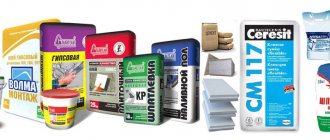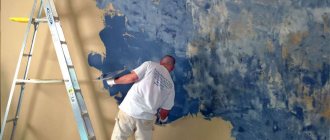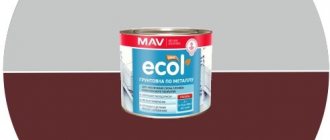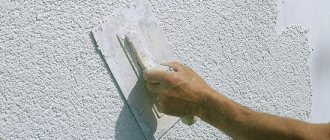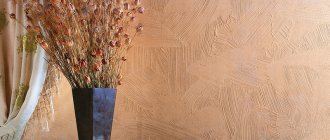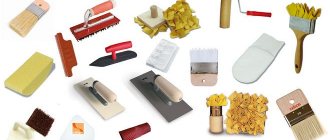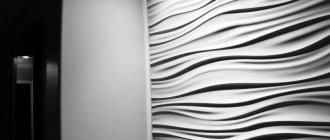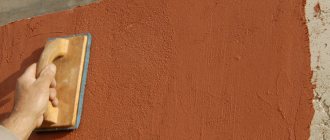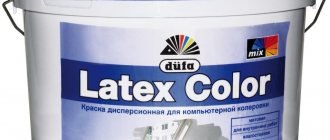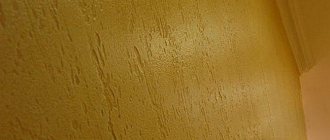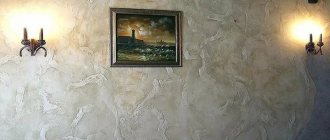Decorative plaster is a general name for a group of building materials that are used for finishing surfaces indoors or outdoors. As the name implies, such compositions are used only for decorating walls and ceilings. Of course, they can also be used to level walls, but due to the relatively high cost, it is better to use them for their intended purpose. Before starting finishing work, you need to find out the consumption of decorative plasters per 1 m2 in order to buy the required amount of the mixture.
Textured solutions
Such mixtures are used to create coatings that imitate the texture of natural stone, leather, wood and other textures. This type of plaster boasts one of the lowest costs, which ranges from 0.9 to 1.5 kg per square meter. To calculate more accurately, you must first determine the grain size of the solution. If it contains fine components (about 1 mm), then the consumption will be minimal, since the thickness of the layer must correspond to the grain size in the mixture. If the grains reach 2-3 mm, then approximately 1.2 kg of textured mixture per square meter will be required. For coarse-grained materials, the consumption of decorative plaster increases to 1.5 kg.
Decorative plaster imitating the texture of wood, characterized by low material consumption
For example, we have a wall with an area of 10 square meters. m, which needs to be covered with a textured solution of medium dispersion in two layers. We multiply the size of the wall area by the material consumption, and then by the number of layers, we get: 10x1.2x2= 24 kg. This is exactly how much textured plaster will be needed to treat the surface of a given area.
Important! The thickness of the total textured layer should not exceed 1 cm, that is, if a material with coarse grains is used, then a maximum of two layers can be applied.
The thickness of the plaster layer directly depends on the source material
Application technology
Ceresit bark beetle plaster is quite popular among consumers. The consumption per 1 m2 of this mixture will be 3.2 kg. Application is carried out in the traditional way. The surface of the walls is cleaned, freed from old finishing, and dirt is removed from it. If the room is damp, then it is necessary to carry out antiseptic impregnation. If there are rusts or deep cracks on the base, they should be repaired with gypsum putty.
You can allow height differences within 1 mm per 1 m. If necessary, the walls are leveled. The surface is coated with a primer to prevent excessive moisture absorption by the plaster. If the coating is treated with a lime-sand composition, then you can refuse to apply a primer
Before applying the mixture, it is important to study the specifics of use. By now you should already have determined the consumption of “Bark beetle” plaster per 1m2
The mixture is applied to a grater or spatula, and then applied to the surface. In this case, the tool must be held in relation to the base at an angle of 60°. The layer thickness should not be less than the grain size. You can determine this visually. If, when leveling the layer, you see grooves, then this is the required thickness.
Consumption of structural compositions
Structural plaster is a finishing material that can be made based on acrylic resins, cement or gypsum. Flour or natural stone chips are used as filler. The main feature is that after the material dries, a surface with deep relief patterns is formed. As for consumption, it depends on the composition of the finishing material:
Relief pattern of structural plaster
- Solutions with quartz chips are consumed in the same way as textured ones, since the thickness of the layer must correspond to the size of the filler fraction. If the solution contains grains up to 2 mm in size, then the consumption will be about 2 kg per square meter; if the grain diameter is 2-3 mm, then 2.5-3 kg will be required to treat 1 m2 of surface. Typically, such mixtures are supplied in 25 kg bags, so for a wall of 10 sq. m will need 1-2 bags, depending on the fraction.
- Materials that are made on the basis of acrylic resin dispersions are a homogeneous paste interspersed with small grains up to 2 mm. The plaster is supplied ready-made, so its consumption is higher: for a 1 mm fraction - 2.5 kg per 1 m2, for a 2 mm grain - 3 kg per square meter. m. Typically, such compositions are supplied in plastic containers of 15 kg. For a wall of 10 sq. m. you will need two such containers, provided that one layer is applied.
- Also quite popular are structural plasters based on marble chips or mixtures of marble and granite, quartz, malachite and other natural stones. Such compositions can be applied in a layer of 1 to 3 mm, depending on the desired depth of texture. Material consumption per 1 square meter of treated surface with a layer thickness of 1 mm will be 1 kg. For processing one wall of 10 square meters. m is enough for one bag of material (25 kg). If you plan to apply two layers, it is better to purchase 2 bags.
- Another common type of structural plasters are materials based on synthetic acrylic resins. Most often they are used for finishing fireplaces, stoves and other surfaces that are exposed to high temperatures. Material consumption also depends on the filler fraction: 0.7-1 mm – 1.5 kg, 1.2-1.5 mm – 2 kg, 2-2.5 mm – 2.5 kg. The solution is supplied in 15 kg containers, so to finish a wall of 10 square meters. m will require 1-2 containers, depending on the size of the fraction.
What factors influence the consumption of plaster mixture
The consumption of the plaster mixture is primarily affected by the curvature of the walls and what kind of plaster will be used. The curvature indicator will primarily affect how much material will be used to level the walls. For a typical new building, the curvature indicator can reach 2-2.5 cm.
Manufacturers usually indicate the amount of mixture consumed per m², but you can see the approximate consumption depending on the material in the table below.
There are also secondary factors - for example, the method of applying the composition or the experience of the artist. Machine application of plaster reduces costs compared to manual application.
It is also important what kind of coating the plaster will be applied to. For example, it is not recommended to apply a coating thicker than 2 cm to a brick unless reinforced mesh is used
Brick
Brick is a popular coating, so proper application of plaster on it is important. One of the easiest ways to apply plaster to it is to spray it
The brush is dipped into the plaster and then hit on a stick. Splashes of plaster remain on the façade. The best result is achieved if 2-3 layers of primer are applied on top of the spray and then a thin coating is applied. The recommended calculation of the thickness of a plaster facade when applied to brick is as follows:
One of the easiest ways to apply plaster to it is to spray it. The brush is dipped into the plaster and then hit on a stick. Splashes of plaster remain on the façade. The best result is achieved if 2-3 layers of primer are applied on top of the spray and then a thin coating is applied. The recommended calculation of the thickness of a plaster facade when applied to brick is as follows:
- spray 4-5 mm;
- soil (several layers) 5-7 mm;
- cover 2 mm.
Concrete
Applying plaster to concrete also requires the use of reinforced mesh. The maximum permissible layer is 20-25mm.
The difference from brick in the work is that the spray must be leveled. The main layer of plaster is applied to the concrete by throwing, work is carried out from the corner, starting from the bottom of the wall.
Calculation of façade thickness:
- spray 5 mm;
- base layer 10-15 mm;
- cover 2 mm.
Aerated concrete
Aerated concrete is a more “capricious” coating, and therefore before applying plaster it must be primed 2-3 times. This will increase the adhesion of aerated concrete and plaster, and will also reduce the likelihood of fungus.
The thickness of the layer on the wall should be on average 4-8mm for interior spaces and 7-9mm for facades. The plaster is applied by throwing, from bottom to top.
Tree
Applying plaster to wood is similar to how it is applied to concrete. The first coat is sprayed, then one coat of primer and then the final coat. Plaster is applied to a wooden surface from top to bottom.
The thickness of the facade will be:
- spray 10-15 mm;
- soil 5-7 mm;
- overlay 2 mm.
After the walls have dried, it is advisable to additionally rub them down.
Bark beetle plaster consumption
Decorative bark beetle plaster belongs to the structural category, but it has gained such popularity that it is worth talking about it separately. The consumption of bark beetle plaster varies from 2.4 to 4 kg per 1m2. This discrepancy is explained by the different grain sizes that are used for manufacturing, as well as the thickness of the layer. To determine the amount of solution that will be required for finishing work, it is recommended to consult with the salesperson in the store, and also read information from the manufacturer.
The consumption of bark beetle plaster depends on the grain fraction of the filler
You should know! After the calculation, you need to add 10% of the reserve, which will be needed if the plaster dries out or falls out of the container during work.
Also, the consumption of this material depends on the characteristics of production, namely, on the amount of water in the solution. For example, bark beetle plaster from the manufacturer Volma requires 6 kg per 1 square meter with a layer thickness of 1 cm. At the same time, the consumption of bark beetle under the Starateli brand is 9 kg per square meter. At first glance, the difference is not that big, but if you consider that the material is supplied in 25 kg bags, then to plaster a wall of 10 m2 you will need 3 bags of Volma bark beetle plaster and 4 from Starateli. Total: the difference is 1 bag for one layer, respectively, with 2 layers the difference will be 2 bags, and if we take into account four walls in the room, then the difference for finishing one room is 8 bags. In addition, the consumption per 1 m2 of finished materials and dry mixtures of bark beetles is also very different.
Ready-made bark beetle plaster solution
What criteria need to be taken into account
The consumption of decorative plaster per 1 m2 is determined taking into account the following nuances:
- Wall condition
— the amount of plaster consumed depends on the number of defects on the panel. In new buildings in apartments, the level of curvature of surfaces reaches 20 cm. In the premises of old housing stock, it is possible to have aligned walls or panels without repair with large curvatures.
- With large
height differenceYou will need to perform leveling in advance using standard plaster using beacons. Then the decorative mixture is applied. The volume of materials in this case will be large.
- Substrate quality
— the structure and level of adhesion of surfaces made of wood, concrete, plasterboard sheets and brickwork are different.
- Type of plaster
— consumption per 1 m² depends on the composition of the mixture, the technique of execution (textured, smooth, textured coating, “bark beetle”, “fur coat”, etc.).
- Square
finishing, size of fractions in the composition, thickness of the layer of plaster mixture.
- Standard volume
Material consumption is indicated on the label and in the instructions from the manufacturer.
Venetian plaster consumption
Venetian plaster is a very popular type of decorative finishing materials. With its help, they create coatings that imitate natural marble with its shine and tints of color. This solution has the lowest consumption among other plasters. But this attractive indicator is achieved due to the ideal leveling of the surface, which, coupled with the cost of work and the prices of the Venetian itself, makes this type of coating the most expensive. The consumption of such material ranges from 70 to 200 grams per 1 m2.
Venetian plaster has the lowest consumption among other decorative mixtures
Since the walls are perfectly smooth, the thickness of the layer, and accordingly the required amount of composition, depends only on the desired effect. The greater the depth of color the customer wants to achieve, the more solution will be required per square meter.
Calculation rules
To calculate the required amount of mixture you will need:
- calculate the thickness of the applied layer;
- clean the wall from dirt and dust;
- install beacons along the entire plane of the wall being treated;
- select several points on the wall, using them you can check the deviation from a given plane. The more points are selected, the more accurate the final calculation result will be. Experts generally select three points to measure deviations;
- measure deviations from a given plane, summarize the results of deviations and divide by the number of selected points.
To make the methodology more understandable, let's carry out all the necessary calculations in practice.
How to reduce the consumption of decorative plasters
The prices for this material are not very high, but if you take into account the entire volume of necessary solutions and the cost of finishing work, you can get a fairly large amount. Therefore, it is recommended to follow simple rules that will help you save a little and reduce material consumption per m2:
- Use cheap cement-based mixtures for rough work.
- During the initial finishing, try to level the surface as much as possible so that the walls are covered no more than 5 mm.
- If the walls have significant curvature, it is more advisable to use plasterboard slabs to level the surface.
- Use primers that are recommended by plastering manufacturers, even if they are expensive.
Planning repair work is one of the most important stages of this event. A correctly calculated amount of material, as well as the selection of suitable consumables, will protect the customer from possible deception on the part of workers and the need to purchase additional solution during finishing.
Technology for decorating walls with ready-made mixtures
Classic textured plastering technology
The main stages of independent finishing work are indicated in the diagram. Let's consider each of the listed stages in more detail.
Important: In order to achieve optimal results when plastering with ready-mixes, it is advisable to use all materials, including mixtures, primers and wax, produced by the same brand. This recommendation is due to the fact that materials within the same brand may be more compatible than materials produced by different brands.
Preparatory work
The photo shows preparatory leveling of the surface with latex putty.
At the initial stage, we prepare the surface by leveling it with putty. We select the leveling material in accordance with the type of surface to be finished and in accordance with the intensity of the relief.
It is preferable to use ready-made latex mixtures. The advantage of this choice is the possibility of sealing large reliefs in one layer, as well as the simplicity and short time of leveling the walls.
The instructions for leveling with the finished mixture are as follows:
- mix the mixture in a bucket until the optimal consistency is obtained;
- Use a narrow spatula to scoop up the mixture and spread it along the edge of a wide spatula;
- We apply a wide spatula to the wall surface at an angle of 30 degrees;
- move the spatula, evenly distributing the putty over the surface;
- After complete drying, the surface can be sanded and thus remove small irregularities.
If you have to level large surfaces, in order to save money, instead of latex putty, you can purchase a dry gypsum mixture, the price of which is low.
Wall primer
Application of primer increases adhesion of walls and plaster
In order to remove dust from the surface and provide equal absorbency to its various areas, a deep penetration primer is used.
Note! Deep penetration primers are universal compounds characterized by increased penetrating ability. Such products can be applied to various building surfaces. The primer penetrates into the micropores of the building material and hardens there, increasing the strength of the surface being finished.
On average, it takes at least a day for such impregnations to dry completely. After the penetrating primer has been absorbed and dried, we apply a covering tinted primer. The use of a covering primer allows you to increase the adhesion of walls and the plaster layer and reduce the consumption of the plaster layer due to uniform painting of the surface.
Important: In order to prevent the appearance of mold on finishing materials, it is recommended to choose soil with the addition of antiseptics.
The instructions for applying primer are as follows:
- add a color matched to the container with the covering soil and mix thoroughly;
- pour some of the primer into the paint trough;
- dip the fluffy roller into the trough, straining out excess material;
- roll the wall with a roller, periodically dipping the tool into the paint trough.
The covering primer dries within 2-3 hours. After the surface has completely dried, we run it across it in different directions with a wide spatula in order to peel off the smallest irregularities and smudges of soil.
Preparation of finishing material
The finished plaster mixture is sold in hermetically sealed plastic containers. The mixture is initially unpainted, and therefore we order tinting or purchase a color scheme.
Important: When mixing the mixture with the color, we take into account the consumption of Venetian plaster per 1 m2. If you mix less than necessary, it will be difficult to get a completely identical color during subsequent mixing. We also remember that the plaster mixture will practically not change color when it dries, as happens with paint. Therefore, choosing a color with greater intensity is not advisable.
Add the color to the mixture and mix thoroughly for 3-5 minutes. It should be mixed immediately before starting work, as the composition quickly separates and the color rises to the top.
For mixing, we use a powerful drill with variable speed control and a stirrer attachment. We set the speed on the drill to a minimum so as not to splash the semi-liquid composition.
Applying plaster
Scheme for applying textured finish
The instructions for applying the finished mixture are as follows:
- Using a narrow spatula, take the solution from the container and apply it to a trowel or wide spatula;
- We apply the tool to the surface of the walls and apply individual strokes in a random direction with the edge of the trowel;
Traditionally, Venetian plaster is applied using the long edge of a trowel.
- after the first layer is applied, wait for complete drying for 2-3 hours;
- Using a wide spatula, we clean the surface of the already dried first layer;
- just as when applying the first layer, apply the second layer of plaster using random strokes;
You can apply a textured pattern with squeegee
- after the second layer has completely dried, apply a translucent third layer with a wide spatula, the thickness of which does not exceed 1 mm.
Finishing
After the third layer has dried, we develop the design by ironing the surface. In this case, we use a stainless steel trowel with medium pressure to move along the finish, smoothing the surface of the plaster. The process continues until the texture of the strokes applied in three layers appears. The more randomly the strokes are applied, the more attractive the texture will be.
